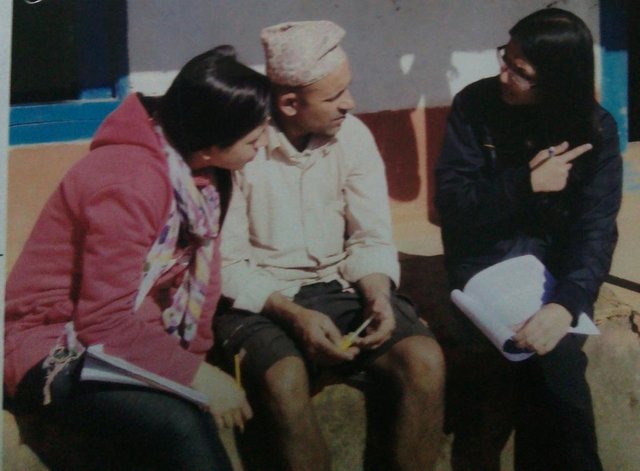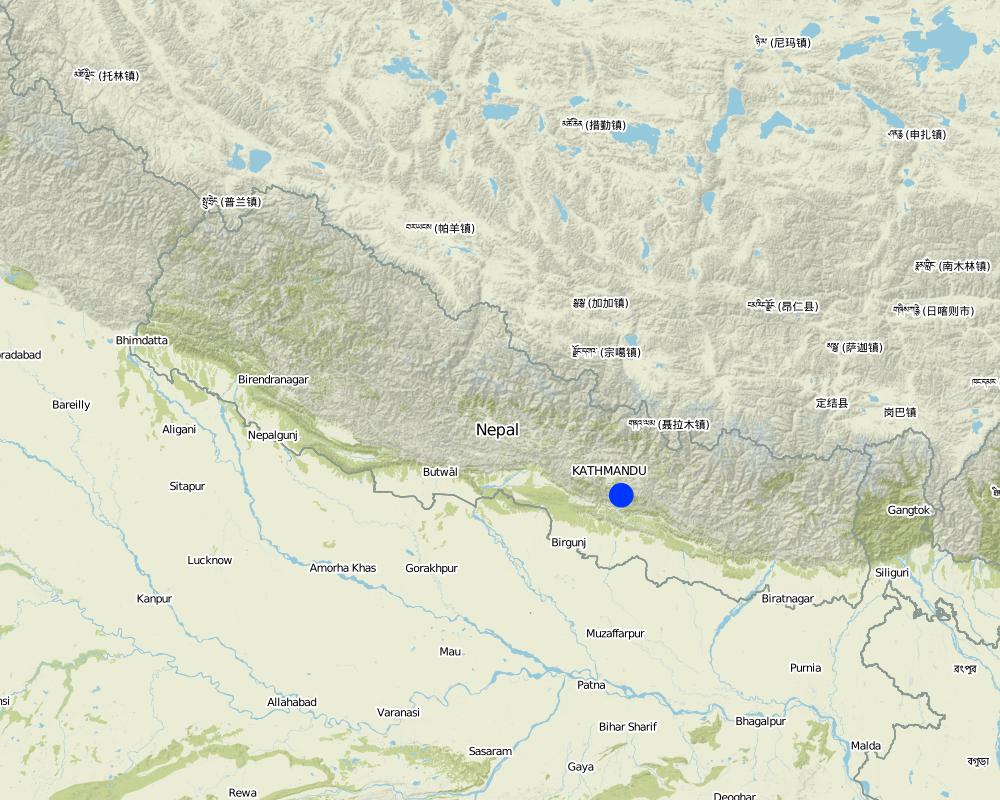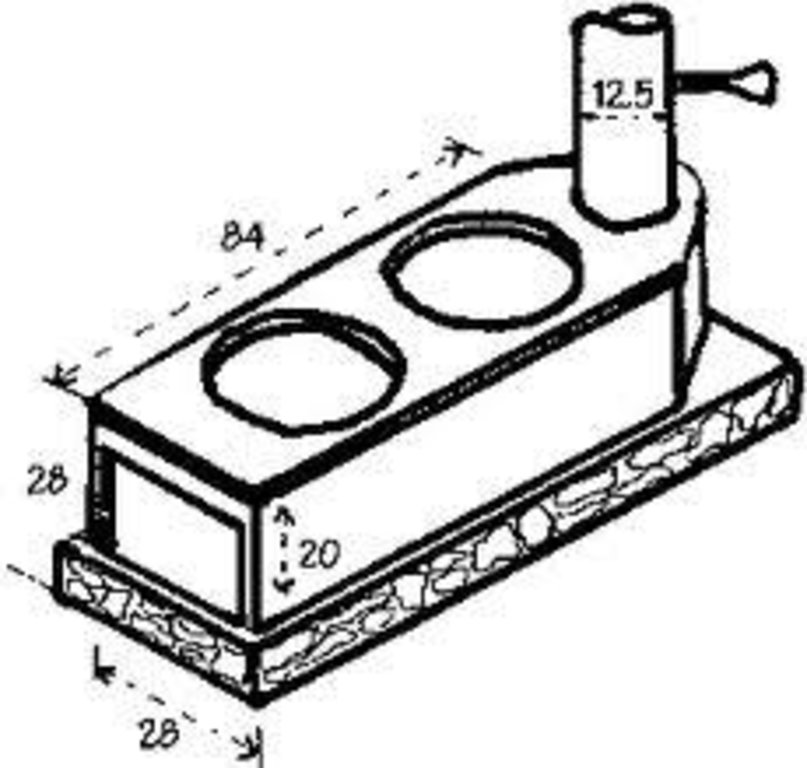Improved Stove for household cooking use [尼泊尔]
- 创建:
- 更新:
- 编制者: Sabita Aryal
- 编辑者: –
- 审查者: David Streiff
Sudhariyeko chulo
technologies_1202 - 尼泊尔
查看章节
全部展开 全部收起1. 一般信息
1.2 参与该技术评估和文件编制的资源人员和机构的联系方式
SLM专业人员:
Shrestha Ishani
Kathmandu University
尼泊尔
SLM专业人员:
Manandhar Shishir
Kathmandu University
尼泊尔
有助于对技术进行记录/评估的机构名称(如相关)
Kathmandu University (KU) - 尼泊尔1.3 关于使用通过WOCAT记录的数据的条件
编制者和关键资源人员接受有关使用通过WOCAT记录数据的条件。:
是
1.4 所述技术的可持续性声明
这里所描述的技术在土地退化方面是否存在问题,导致无法被认为是一种可持续的土地管理技术?:
否
1.5 请参阅有关SLM方法的问卷

Chyamrangbesi - A smoke free zone by using … [尼泊尔]
The ways and means used to promote and implement to improved stove to improve human well-being and sustainable land use.
- 编制者: Sabita Aryal
2. SLM技术的说明
2.1 技术简介
技术定义:
The technoloigy is engineered in such a way that there will be less consumption of wood and less emission of smoke.
2.2 技术的详细说明
说明:
The technology document is entitled"improved Stove In Rural Areas".This technology brings more effective way of cooking compared to the old one.Here,unlike the rural areas wood consumption is lesser and wood consumption is lesser and there is also proper outlet of smoke produced.In the old stove more wood and fuelwood were consumed and smoke were accumul;ated in the cooking site which is the kitchen.Thus it reduces health hazards.
Here we have a single input area to enter the fuelwood for a pair os stoves. This is done because the heat pressure is not allowed to escape and the same heat produced shifts in the other stove and helps in heating.
Purpose of the Technology: The purpose cof the technology was to reduce the health hazards due to accumulation of smoke in the kitchen to reduce the fuelwood consumption, to save time in cooking and hence to maintain a smoke free zone.
Establishment / maintenance activities and inputs: The plant was first initiated by VDC in magh(2068B.S) by the assistance of Remerick Chyamrangbesi VDC and other co operatives.The first step was that labourers and technicians were given training an how to set up the stoves.Then they were assigned to construct it in homes.The labour charge and wages were covered by the organisation.The skills were not hightech so the skill was passed to the individuals of house and the maintenance was done.
Also, the organization send a person per year to if the stove is in proper working condition or not.
Natural / human environment: The technology mainly focuses on the health of the people exposed due to the indoor pollution.Since there was proper outlet no smoke was trapped inside which massively reduced air pollution.Besides less firewood was consumed,hence reducing the rate of deforestation and smoke emission.Also the ashes obtained from the burning firewood was a good fertilizer.
2.5 已应用该技术的、本评估所涵盖的国家/地区/地点
国家:
尼泊尔
区域/州/省:
Chyanrangbesi
有关地点的进一步说明:
Kavrepalanchowk
Map
×2.6 实施日期
如果不知道确切的年份,请说明大概的日期:
- 不到10年前(最近)
2.7 技术介绍
详细说明该技术是如何引入的:
- 通过项目/外部干预
注释(项目类型等):
Feb 2012: initiation by 24th Jestha
3. SLM技术的分类
3.1 该技术的主要目的
- 创造有益的社会影响
3.2 应用该技术的当前土地利用类型

定居点、基础设施
- 能源:管道、电线
注释:
Major land use problems (compiler’s opinion): Irrigation facilities were not monitored.
3.4 该技术所属的SLM组
- 节能技术
3.5 技术传播
具体说明该技术的分布:
- 适用于特定场所/集中在较小区域
注释:
The village Chyangbesi has an area of 28.97 sq km. (source VDC database)
3.6 包含该技术的可持续土地管理措施

其它措施
3.7 该技术强调的主要土地退化类型

生物性退化
- Bq:数量/生物量减少
注释:
Main causes of degradation: deforestation / removal of natural vegetation (incl. forest fires) (Deforestation for fuelwood)
3.8 防止、减少或恢复土地退化
具体数量名该技术与土地退化有关的目标:
- 防止土地退化
- 减少土地退化
4. 技术规范、实施活动、投入和成本
4.1 该技术的技术图纸
4.2 技术规范/技术图纸说明
Two stoves are attached and firewood you require for first stove with input only.Heat is transferred to another stove aswell.It works on the principle of heat entrapment.
Location: Chyamrangbesi. Kavre
Date: 3/12/2012
Technical knowledge required for field staff / advisors: low (field staffs taught the technique to local people)
Main technical functions: increase in nutrient availability (supply, recycling,…)
Secondary technical functions: increase in organic matter, promotion of vegetation species and varieties (quality, eg palatable fodder), reduction of dry material (fuel for wildfires)
Structural measure: Soil shape
Vertical interval between structures (m): S,C,E
Structural measure: Iron,Chimney
Vertical interval between structures (m): O
Construction material (earth): soil excavated
Construction material (concrete): Concretes were used to make the structure solid and stable.
Construction material (other): Iron and tin was used to make the chimney and also to suppoirt the structure.
4.4 技术建立活动
| 活动 | 措施类型 | 时间 | |
|---|---|---|---|
| 1. | Technicians were trained by Rimrek | 结构性的 | MAgh 2068 |
| 2. | Construction | 结构性的 | magh 2068 |
| 3. | Final | 结构性的 | Jestha 24,2069 |
| 4. | Materials cost | 结构性的 |
4.5 技术建立所需要的费用和投入
| 对投入进行具体说明 | 单位 | 数量 | 单位成本 | 每项投入的总成本 | 土地使用者承担的成本% | |
|---|---|---|---|---|---|---|
| 劳动力 | Labour | unit | 1.0 | 400.0 | 400.0 | |
| 技术建立所需总成本 | 400.0 | |||||
4.6 维护/经常性活动
| 活动 | 措施类型 | 时间/频率 | |
|---|---|---|---|
| 1. | Monitoring | 结构性的 |
4.7 维护/经常性活动所需要的费用和投入(每年)
注释:
Machinery/ tools: Hand hoe
Labours as raw materials and ingrediaments were locally available, and hence free.Thus expenses was mainly on labour charge.Mininmum quantity of iron were used but so it was negligible.
4.8 影响成本的最重要因素
描述影响成本的最决定性因素:
Labour Skills: Initially the skilled people were hired to construct the stove and then the skills were acquired by the villagers so thet they can themselve make it onwards.The raw materials required were locally available which reduced the cost.
5. 自然和人文环境
5.6 应用该技术的土地使用者的特征
非农收入:
- 收入的10-50%
相对财富水平:
- 贫瘠
- 平均水平
个人或集体:
- 团体/社区
性别:
- 女人
- 男人
说明土地使用者的其他有关特征:
Land users applying the Technology are mainly common / average land users
5% of the land users are rich and own 20% of the land.
85% of the land users are average wealthy and own 70% of the land.
10% of the land users are poor and own 10% of the land.
Off-farm income specification: There wasn't any significant charge in the economy but pollution was kept in check and reduce future expenses in terms of medical expenditure.
5.7 应用该技术的土地使用者拥有或租用的平均土地面积
- < 0.5 公顷
- 0.5-1 公顷
- 1-2 公顷
- 2-5公顷
- 5-15公顷
- 15-50公顷
- 50-100公顷
- 100-500公顷
- 500-1,000公顷
- 1,000-10,000公顷
- > 10,000公顷
这被认为是小规模、中规模还是大规模的(参照当地实际情况)?:
- 小规模的
5.8 土地所有权、土地使用权和水使用权
土地所有权:
- 社区/村庄
土地使用权:
- 社区(有组织)
用水权:
- 社区(有组织)
注释:
Every household had their own land property. But common areas and forests were used for utilization of fuel.
5.9 进入服务和基础设施的通道
健康:
- 贫瘠
- 适度的
- 好
教育:
- 贫瘠
- 适度的
- 好
技术援助:
- 贫瘠
- 适度的
- 好
就业(例如非农):
- 贫瘠
- 适度的
- 好
市场:
- 贫瘠
- 适度的
- 好
能源:
- 贫瘠
- 适度的
- 好
道路和交通:
- 贫瘠
- 适度的
- 好
饮用水和卫生设施:
- 贫瘠
- 适度的
- 好
金融服务:
- 贫瘠
- 适度的
- 好
6. 影响和结论性说明
6.1 该技术的现场影响
社会经济效应
生产
作物生产
注释/具体说明:
Ash was used as fertiliser
收入和成本
工作量
注释/具体说明:
Less firewood consumption
社会文化影响
健康状况
SLM之前的数量:
N/A
SLM之后的数量:
N/A
注释/具体说明:
Reduce indoor pollution
livelihood and human well-being
注释/具体说明:
Specifically,the health hazards due to indoor air pollution and smoke effects has massively reduced.
生态影响
减少气候和灾害风险
碳和温室气体的排放
SLM之前的数量:
N/A
SLM之后的数量:
N/A
注释/具体说明:
Less firewood conmsumption so less smoke produced
6.2 该技术的场外影响已经显现
Emission of smoke
注释/具体说明:
Less smoke generated
Health hazards
注释/具体说明:
Systematic arrangement of smoke,less smoke,proper outlet of smoke
6.3 技术对渐变气候以及与气候相关的极端情况/灾害的暴露和敏感性(土地使用者认为的极端情况/灾害)
注释:
Since the technology was indoor none of the above factors had only effect on technology,
6.4 成本效益分析
技术收益与技术建立成本相比如何(从土地使用者的角度看)?
短期回报:
稍微积极
长期回报:
积极
技术收益与技术维护成本/经常性成本相比如何(从土地使用者的角度看)?
短期回报:
中性/平衡
长期回报:
中性/平衡
注释:
Funds were given by VDC for establishment. The locals acquired the skills later and maintainence cost effective.
6.5 技术采用
在所有采用这项技术的人当中,有多少人是自发地采用该技术,即未获得任何物质奖励/付款?:
- 0-10%
注释:
100% of land user families have adopted the Technology with external material support. Remerick and Chyamrangbesi VDC supplied full financial assistance. VDC and Remerick brought the technique and trained the technicians paying their wages. There is a strong trend towards spontaneous adoption of the Technology. Since it is hygenic and pollution free and also there is less consumption of fuel it is growing fast.
6.7 该技术的优点/长处/机会
| 土地使用者眼中的长处/优势/机会 |
|---|
| Health problems resulting from smoke have been less of a problem |
| Time period for cooking was comparatively lesser. |
| 编制者或其他关键资源人员认为的长处/优势/机会 |
|---|
| Less firewood was consumed leading to minimum indoor pollution |
| Saved time in wood collection as less firewood was consumed |
6.8 技术的弱点/缺点/风险及其克服方法
| 土地使用者认为的弱点/缺点/风险 | 如何克服它们? |
|---|---|
| No disadvantages |
| 编制者或其他关键资源人员认为的弱点/缺点/风险 | 如何克服它们? |
|---|---|
| Though lesser smoke is produced smoke is still harmful to atmosphere | Filtering devices can be inserted in chimneys,but that will be expensive. |
| Instead of blowing air by mouth certain mechanical devices can be use | Devices available in market can be used |
7. 参考和链接
7.1 信息的方法/来源
- 实地考察、实地调查
- 与土地使用者的访谈
7.2 参考可用出版物
标题、作者、年份、ISBN:
www.mapkarta.com
可以从哪里获得?成本如何?
Thamel
链接和模块
全部展开 全部收起链接

Chyamrangbesi - A smoke free zone by using … [尼泊尔]
The ways and means used to promote and implement to improved stove to improve human well-being and sustainable land use.
- 编制者: Sabita Aryal
模块
无模块



